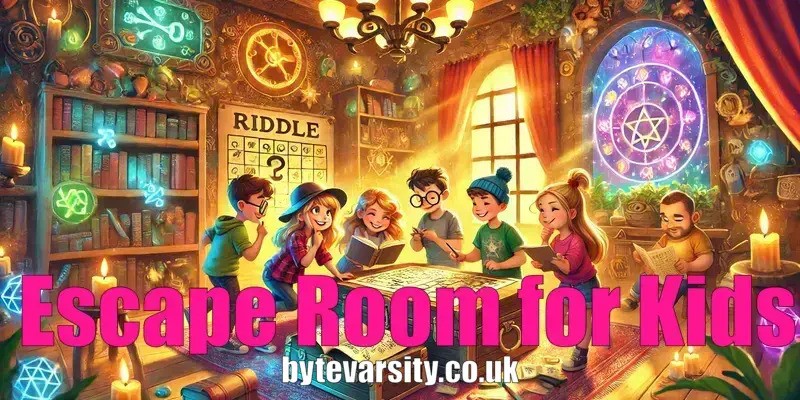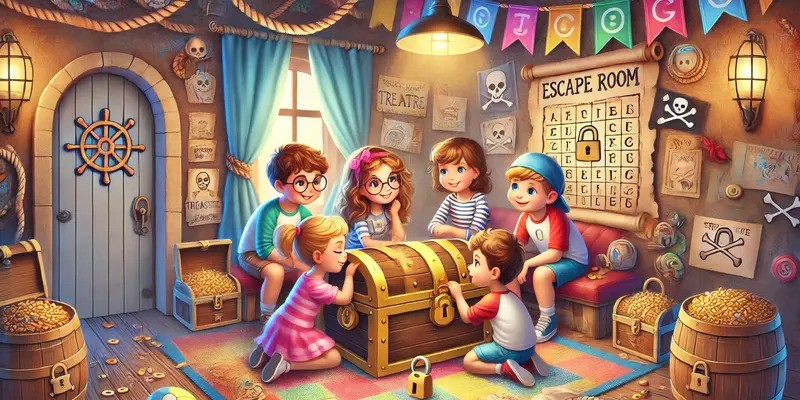Introduction to Escape Rooms for Kids
Escape rooms for kids are captivating and imaginative spaces designed to spark curiosity and creativity. These experiences combine an engaging storyline with a series of puzzles, tasks, and challenges that participants must solve collaboratively within a set timeframe.
Unlike standard recreational activities, escape rooms immerse children in a narrative-driven environment, encouraging them to think critically and interact with their surroundings. Kids are tasked with unlocking clues, decoding messages, and working as a team to achieve the final goal—be it escaping a room or completing a mission.
Escape rooms are increasingly popular for their unique ability to blend entertainment with cognitive development. They offer kids a chance to enhance problem-solving skills, boost confidence, and foster social interaction. Parents and educators also value escape rooms for their role in teaching patience, perseverance, and adaptability.
Whether you visit a professional escape room venue or create one at home, the activity can cater to various interests and skill levels. Escape rooms are also an excellent choice for birthday parties, school events, or family bonding moments.
Ultimately, escape rooms for kids are more than just games—they’re tools for learning, growth, and unforgettable memories.
What is an Escape Room?
An escape room is a physical or digital space designed as a themed puzzle-solving environment. Participants are “locked” in a room and must uncover clues, solve riddles, and complete tasks to achieve a specific objective, such as finding a key or solving a mystery.
For kids, escape rooms are often tailored with age-appropriate challenges and fun themes like pirate adventures, superhero missions, or treasure hunts. These settings encourage exploration and logical thinking while ensuring that young participants remain engaged and entertained.
Unlike traditional games, escape rooms emphasize collaboration and real-world problem-solving. They challenge kids to think outside the box, communicate effectively, and utilize teamwork to overcome obstacles. Every solved puzzle provides a sense of accomplishment, boosting confidence and motivation.
Escape rooms can be found in professional venues, schools, and even at home. They come in various formats, such as tabletop games, virtual simulations, or fully immersive experiences. Regardless of the setup, escape rooms provide an exciting way to engage kids in interactive storytelling and hands-on learning.
Benefits of Escape Rooms for Kids
Escape rooms for kids offer numerous benefits that go beyond mere entertainment. They are educational tools that promote cognitive, emotional, and social development.
- Cognitive Development: Escape rooms challenge kids to think critically, solve complex problems, and make decisions under pressure. This helps improve logical reasoning, spatial awareness, and attention to detail.
- Teamwork and Communication: As a group activity, escape rooms teach kids to collaborate, share ideas, and work toward a common goal. These skills are essential for social and emotional development.
- Confidence Building: Successfully solving puzzles or completing challenges boosts self-esteem and gives kids a sense of accomplishment.
- Creativity and Imagination: Themed environments and storylines inspire kids to use their imagination and think creatively.
Escape rooms are also a fantastic way for families to bond. Parents and kids can collaborate in a fun and engaging way, creating memories and strengthening relationships.
How to Choose the Perfect Escape Room for Kids
Age-Appropriate Themes and Challenges
When selecting an escape room for kids, it’s crucial to consider their age and maturity level. Younger kids may enjoy simpler themes like fairy tales or animal adventures, while older children might prefer mystery or science fiction storylines.
Additionally, the puzzles and challenges should match their cognitive abilities. Overly complicated tasks can lead to frustration, while overly simple ones may not hold their interest. Many escape room venues categorize their rooms by difficulty and recommended age, making it easier for parents to choose.
Group Size and Supervision
The number of participants plays a significant role in the escape room experience. A group that’s too large might become chaotic, while a group that’s too small could struggle to complete the tasks. Ideal group sizes for kids range from 3 to 6 participants.
Supervision is another important factor. While some escape rooms have staff members monitoring the session, parents or guardians should also ensure that the kids are safe and comfortable throughout the activity.

Creating a DIY Escape Room for Kids at Home
Planning the Storyline and Theme
Creating a DIY escape room at home starts with choosing a theme that excites the kids. Consider their interests—pirates, space exploration, or magical kingdoms—and build a storyline around them.
Once the theme is decided, design a plot with a clear goal. For example, the kids might need to find a hidden treasure or save a kingdom from a curse. Write down key plot points and integrate puzzles or tasks that align with the narrative.
Setting Up Puzzles and Clues
The puzzles and clues are the heart of any escape room. Use household items like locks, keys, and boxes to create physical challenges. For example, hide a key inside a locked box and provide clues to its location. You can also incorporate riddles, word searches, or math problems to add variety.
Make sure to test the escape room before the kids participate to ensure that everything runs smoothly. Set a time limit and watch as the kids immerse themselves in the experience.
Popular Escape Room Themes for Kids
Mystery and Detective Themes
For kids who love solving puzzles and cracking codes, mystery-themed escape rooms are an exciting choice. These rooms challenge children to find hidden objects, decode secret messages, and piece together clues to solve a thrilling case. Whether it’s tracking down a sneaky thief or uncovering a lost treasure, these adventures spark curiosity and keep young minds active.
Fantasy and Adventure Themes
Fantasy-themed escape rooms transport kids to magical worlds filled with wizards, enchanted forests, and mythical creatures. These adventures often involve solving riddles to find hidden treasures, breaking spells, or outsmarting a mischievous villain. By blending creativity with problem-solving, these themes create an immersive and unforgettable experience.
Tips for Ensuring a Safe and Fun Experience
Supervision and Safety Guidelines
When creating or hosting an escape room for kids, safety should be the top priority. Use age-appropriate materials and avoid small or sharp objects. Adult supervision ensures the activity is both safe and enjoyable.
Encouraging Teamwork and Participation
Promote collaboration by encouraging kids to share ideas and solve puzzles together. Celebrate their efforts to make the experience rewarding and enjoyable, regardless of the outcome. Read More about Lifestyle topics related to home activities at byte varsity.
